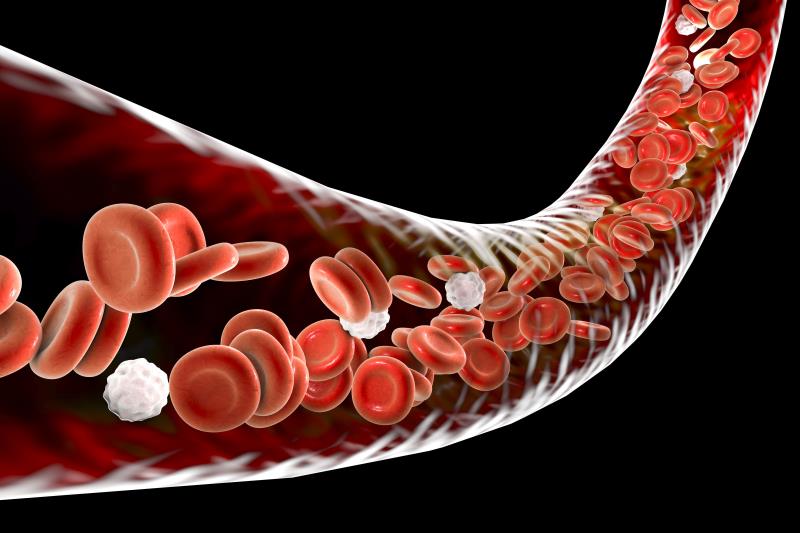
Dropping aspirin after 3 months of dual therapy with ticagrelor reduced bleeding in patients with diabetes who have undergone PCI* vs taking both agents for 1 year, the TWLIGHT-DM** study has shown, consistent with benefits seen in TWILIGHT for other high-risk patients.
“In patients with diabetes, treatment with ticagrelor alone significantly reduced clinically relevant bleeding compared with ticagrelor plus aspirin, without increasing the risk for additional heart attacks, strokes, or death,” said study first author Professor Dominick J. Angiolillo from the University of Florida College of Medicine in Jacksonville, Florida, US, at ACC.20.
In the TWILIGHT trial, high-risk*** patients (n=9,006) who had undergone PCI with drug-eluting stents and received the DAPT combination of ticagrelor (90 mg BID) and aspirin (81–100 mg/day) for 3 months were randomized to continue this strategy or receive ticagrelor plus placebo (ticagrelor monotherapy) for 12 months.
The present findings are the result of a pre-specified analysis of the 2,620 patients with insulin- or medically-treated physician-diagnosed DM (mean age 64.8 years, 23.6 percent female, 61.6 percent with acute coronary syndrome [ACS]) enrolled in the TWILIGHT trial, of whom 1,319 and 1,301 received ticagrelor monotherapy and ticagrelor-aspirin, respectively. Patients with DM had a higher prevalence of comorbidities and multivessel coronary artery disease (CAD) compared with the rest of the study population.
The results showed that the overall findings of reduced bleeding without ischaemic harm with ticagrelor monotherapy as demonstrated in TWILIGHT were consistent among patients with DM. In the intention-to-treat (ITT) population, ticagrelor monotherapy recipients had a reduced incidence of BARC# 2, 3, or 5 bleeding compared with ticagrelor-aspirin recipients over the 12-month treatment period (4.5 percent vs 6.7 percent; hazard ratio [HR], 0.65, 95 percent confidence interval [CI], 0.47–0.91; p=0.012). [ACC.20, abstract 20-LB-20402-ACC; J Am Coll Cardiol 2020;doi:10.1016/j.jacc.2020.03.008]
The results were consistent across various pre-specified bleeding endpoints including BARC 3 or 5 bleeding (HR, 0.34; p=0.001), Thrombolysis in Myocardial Infarction (TIMI) minor or major bleeding (HR, 0.65; p=0.01), Global Use of Strategies to Open Occluded Arteries (GUSTO) moderate or severe bleeding (HR, 0.29; p=0.001), and International Society of Thrombosis or Hemostasis (ISTH) major bleeding (HR, 0.44; p=0.004).
“These findings … were seen across all types of diabetes patients, irrespective of their clinical presentation [ACS or CAD] and the treatment they were receiving for their diabetes,” said Angiolillo.
Additionally, there was no increase in ischaemic events## with ticagrelor monotherapy compared with ticagrelor-aspirin (4.6 percent vs 5.9 percent; HR, 0.77, 95 percent CI, 0.55–1.09; p=0.14) in the per-protocol cohort.
This was also consistent among all pre-specified ischaemic endpoints namely cardiovascular mortality, myocardial infarction (MI), or stroke (HR, 0.80; p=0.21), all-cause mortality (HR, 0.67; p=0.20), MI (HR, 0.75; p=0.18), ischaemic stroke (HR, 1.58; p=0.42), and definite or probable stent thrombosis (HR, 0.66; p=0.42).
Exploratory analysis of a net adverse clinical event endpoint – comprising BARC 3 or 5 bleeding, death, MI, or stroke – in the ITT population was also lower among ticagrelor monotherapy compared with ticagrelor-aspirin recipients (5.4 percent vs 8.7 percent; HR, 0.61; p=0.001), with a number needed to treat with ticagrelor monotherapy of 30 to prevent one event at 1 year.
Clinical implications
While DAPT comprising a P2Y12 inhibitor and aspirin is the standard of care to prevent post-PCI thrombotic complications, long-term exposure to this combination raises bleeding risk, said the authors.
“Overall, these results demonstrate that the clinical benefits and safety of ticagrelor monotherapy observed in the main TWILIGHT trial cohort are preserved among patients with DM,” noted Angiolillo and co-authors.
“These findings support such a bleeding avoidance strategy, which can be implemented without any signals for harm even in high-risk patients such as those with DM,” said Angiolillo.
“[Furthermore, the lack of worsening of ischaemic outcomes is] an important finding given the well-established associations between DM and systemic atherothrombosis. These findings are noteworthy in light of the high-risk profile for both ischaemic and bleeding complications of this ever-growing cohort of patients,” the authors added.
They noted that the findings do not apply to patients with ST-elevation MI (STEMI) who were excluded from the trial and may not be generalizable to other oral P2Y12 inhibitors. The study was also not sufficiently powered to detect between-group differences for rare outcomes such as stent thrombosis or stroke.